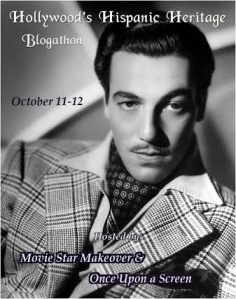
My article is part of a month-long celebration of Hispanic Heritage and culture and is a homage to Hispanic contributions to American Classic Cinema for Hollywood’s Hispanic Heritage Blogathon.
I have to admit I fell in love. I was only 7 or 8, but the first time I saw The Little Princess on our black and white Philco, Cesar Romero, as Ram Dass, took my heart away and always kept it. He saved little Shirley Temple as Sara from all the people in the film who tried to keep her from her father. When she was about to give up, he furnished her little attic room with luxurious clothes, delicious, hot food, a comfy cover on her bed, and the warm feeling that she wasn’t alone in her daily struggles. How could I not admire and adore Romero after seeing how kind he had been to a little orphan girl? I hoped that if I was ever in such circumstances that I would find someone to protect me like that if my Daddy were to disappear from my little life.
I have a white rose to tend
In July as in January;
I give it to the true friend
Who offers his frank hand to me.
And for the cruel one whose blows
Break the heart by which I live,
Thistle nor thorn do I give:
For him, too, I have a white rose.

José Julián Martí Pérez (January 28, 1853 – May 19, 1895) was a Cuban national hero and an important figure in Latin American literature. In his short life he was a poet, an essayist, a journalist, a revolutionary philosopher, a translator, a professor, a publisher, and a political theorist.
Poet, teacher, and revolutionary Jose Marti’s poem, “I Have a White Rose” in some ways symbolizes the generosity of spirit that Cesar Romero, as Ram Dass, shares with little Sara (Shirley Temple) in The Little Princess. Ram Dass gives sustenanace to a little lost child so that she can share in the joy he knows is still part of her heart even though adversity surrounds her. But Marti’s poetry is not perhaps the only connection to Romero.
“A violet duchess careens
In the arms of a red coat:
A painted viscount of note
Keeps time on a tambourine.”
(Translated Excerpt from “Estoy en un baile extrano” by Jose Marti.)

Cesar Romero, born to Cuban parents in New York City on February 15, 1907, went to Collegiate and Riverdale County Schools before beginning his foray into the entertainment industry as a ballroom dancer. First appearing on Broadway in the 1927 production of Lady Do, and then in Strictly Dishonorable, his first film role came in The Shadow Laughs (1933), and he then garnered more favorable exposure in The Devil is a Woman (1935). In 1937, he appeared first with Shirley Temple in Wee Willie Winkie, and again teamed with Temple in The Little Princess in 1939, the film that inspired me to choose Romero as my topic for Hollywood’s Hispanic Heritage Blogathon. Romero’s kindness and generosity in the role always reminds me of my father’s willingness to help others.
According to several sources, Romero’s maternal grandparents were exiled Cubans Carmen and her invalid husband, Manuel Mantilla. Their daughter, María Mantilla — Romero’s mother — is generally believed to have been the daughter of Cuban poet and revolutionary hero José Martí, who wrote the verses used in “Guantánamera” (“Yo soy un hombre sincero…”).
Romero’s versatility lent his talents initially to the stable of stereotypical Latin lotharios in Hollywood, but many of his more in-depth roles began to reveal his ability to play drama, comedy, and a mixture of the two. His popularity had many phases, which illuminate how intrinsic his international characters were to plot development in Hollywood from the 1930’s to the 1990’s, as his roles changed from the sexy, well-dressed “eye candy” of his early years to more definitive roles like that of Hernan Cortes in Captain From Castile. Cortes would never look that good again on screen or off.

Some say he would show up for the “opening of a napkin,” but there is no doubt Romero was a popular man-about-town…
Romero’s supposedly savvy deal for the production of the 50’s television program Passport to Danger, where Romero played an international courier dodging bullets and secret agents, had him playing opposite such guest stars as Carolyn Jones, Frank Wilcox, Ted DeCorsia, and Paul Picerni as he cavorted and cajoled his way through weeklly intrigue for four years. (It also allowed him to care for many of his extended family members through the ensuing years, and would not be the only clever business deal he made.) His participation in the series left him financially well-fixed and allowed him to stock his closet, which some say held upwards of 500 suits and tuxedos. Romero believed in dressing welll and living well, and his reputation as a “confirmed bachelor” did nothing to disturb his decades-long popularity with celebrities, and the camera, both in film and television.
The audience’s initial response to Cesar Romero’s appearance on What’s My Line reveals how popular and well-liked Romero’s film, television, and radio appearances have made him to American audiences. As one of the most entertaining appearances on What’s My Line reveals, Romero’s sense of humor belies his ability to entertain. After he disguises his voice to a deep, raspy, whisper, the panel continues to allude to the fact that they think Romero might be a seal as a continuing rhetorical device to elicit laughter from the audience. When Dorothy Kilgallen asks Romero if he ever had a signature laugh, it is more than a decade before Romero’s signature laugh as Batman’s The Joker appears on the American television scene: https://m.youtube.com/watch?v=ve3xrr-Y7oQ
After the heyday of the studios came to a close, Romero began becoming even more visible on primetime television, and his stint as The Joker on the 60’s Batman series left him a little perplexed at times, but certainly grateful and zesty as one of the tallest Jokers at 6’3″ to ever grace the screens.
According to a quote attributed to Romero, he was perplexed about one of his most visible roles and most enduring characters. “Why [producer William Dozier] wanted me for Batman (1966), I’ll never know, because I asked his wife, Ann Rutherford, ‘Why did Bill think of me for this part?’. She said, “I don’t know, Butch. He said he saw you in something, and he said, ‘He’s the one I want to play the Joker’.” I haven’t the slightest idea what it was he saw me in, because I had never done anything like it before.”
The signature Joker laugh also has its origins in a spontaneous moment that became a legendary calling card. His evil giggle as the Joker on Batman (1966) was created almost by accident. Shortly after being cast, Romero met with producers to discuss his role on the series. While waiting to meet with them, he happened to see conceptual art of the Joker’s costuming. Romero felt that the pictures almost look absurd, and as a result, spontaneously broke out into a playfully loud and almost manic laughter. A producer overhearing that laughter, responded by telling Romero “That’s it, that your Joker’s laugh!”.
To listen to Romero’s raucously riotous refrain, follow the link: https://m.youtube.com/watch?v=x5fX4quv7fw
The actor obviously had so much joy with the unusual character: “I had enormous fun playing the Joker on Batman (1966). I ended up doing something like 20 episodes of Batman, as well as the full-length feature film version [Batman: The Movie (1966)]. There was certainly nothing hard about that assignment! Even the makeup sessions weren’t too bad. It took about an hour-and-a-half to put the full makeup on, including the green wig. I didn’t mind it at all.”
As for being stereotyped, Romero stated that “I was never stereotyped as just a Latin lover in any case because I played so many parts in so many pictures. I was more of a character actor than a straight leading man. I did many kinds of characters — Hindus, Indians, Italians. There were very few pictures where I ended up with the girl.” He also played the popular Niarchos opposite Jane Wyman in Falconcrest in the 1980’s, and was cast as Sophia’s love interest in an episode of The Golden Girls that is a fan favorite.
Would his rumored grandfather approve of what Romero did with his ilfe? According to an article written by Kim Ruehl, “Guantanamera” was originally written in 1929 as a patriotic song about Cuba, the rhyme scheme and structure of “Guantanamera” has always lent itself easily to evolution and adaptation – both things necessary for any good protest song. The tune has evolved through the years and been used in struggles for peace and justice across Latin America and the US, and has been recorded by a remarkably long and diverse list of artists, including Joan Baez, the Fugees, Jimmy Buffett, Jose Feliciano, Julio Iglesias, Los Lobos, Pete Seeger, and numerous others. It’s been recorded in Spanish, Italian, French, Welsh, English, and Dutch.
Originally, the lyrics to “Guantanamera” had a romantic spin. It was a song about a love affair gone awry – a story of a woman who gets fed up and leaves her man after being mistreated, possibly in the form of infidelity. Those lyrics quickly fell by the wayside as the song evolved to one about national pride. After all, the first verse of the song was taken from a poem by Cuban freedom activist Jose Marti, an adaptation which cemented it for future use among freedom activists and others struggling for some kind of justice.”
Those lines which open the song translate roughly to English as:
I am a truthful man from this land of palm trees
Before dying I want to share these poems of my soul
“Yo soy un hombre sincero,
De donde crece la palma,
Yo soy un hombre sincero,
De donde crece la palma,
Y antes de morirme quiero
Echar mis versos del alma”
For me, Cesar Romero, grandson of the Cuban poet, Jose Marti, will always be that “hombre sincero,” the Ram Dass of my soul, “de mi alma.”
Notes…
*(Romero’s costume from Wee WIllie Winkie was sold at the Bonham’s auction last year for $1,125, higher than the original auction house estimate. Twentieth Century-Fox, 1937. A long red wool coat with elaborate gold embroidery and epaulettes, bearing a black-lettered United Costumers, Inc. Manufacturers label inscribed in black ink, “Cesar Romero.” Together with a red silk cummerbund to be worn over the coat, also with a black-lettered United Costumers, Inc. Manufacturers label inscribed in black ink, “C. Romero.” Accompanied by a reproduction still showing Romero wearing the coat. The film, directed by John Ford, is based on a Rudyard Kipling story set in Colonial India. Romero, a leading Latin heartthrob of the day, portrays Khoda Khan, an Indian leader who befriends Shirley Temple’s character.)
Christy Putnam received a prestigious Council For Basic Education Fellowship of $3,000 for her article “Malinalli: Cortes’ Mistress and Interpreter” in the 1990’s. She is bilingual, and has traveled to 19 states in Mexico, and Madrid, Spain. She wrote, produced, and directed a young adult play entitled “Origins of Spanish Poetry” in 2008.
Sources include: Cuba Then/The Monacelli Press, Kim Ruehl article, Poemhunter, IMDB, Wikipedia, “Amor con amor se paga” por Jose Marti, El Jardin de las Orquideas, and others.
“Marti found American society to be so great, he thought Latin America should consider imitating America. Marti argued that if the US “could reach such a high standard of living in so short a time, and despite, too, its lack of unifying traditions, could not the same be expected of Latin America?” John M. Kirk, Jose Marti, Mentor of the Cuban Nation
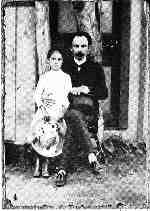
Photo at right:
Martí and María, Cesar Romero’s mother,
who was 10 years old,
on a trip to Bath Beach in 1890.
For more information on the familial relationship of Jose Marti and Cesar Romero, follow the link: http://www.historyofcuba.com/history/funfacts/CesarRom.htm
Certain diacritical markings, like the accent, have not been added in some sections due to technical constraints. The “E” in Jose and the “I” in Marti should have an accent mark, as well as the “I” in Orquideas.






©2014
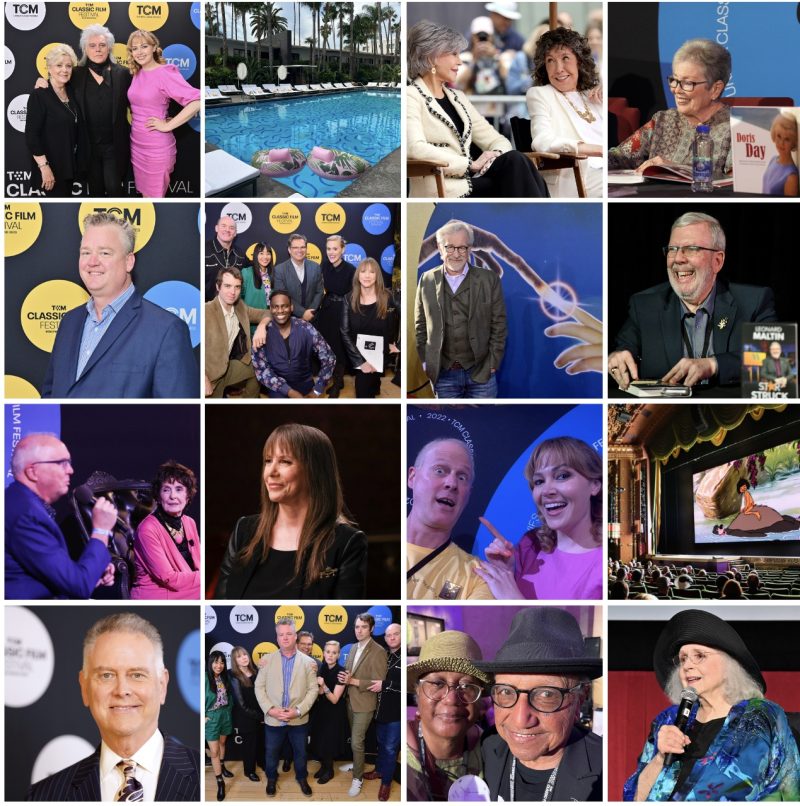
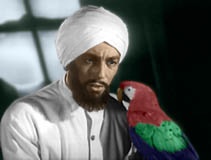
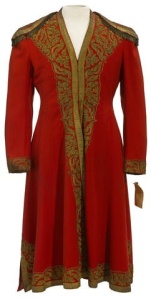

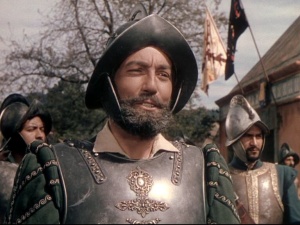
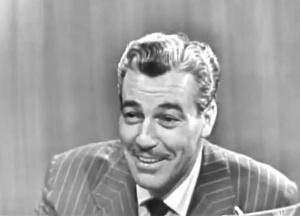
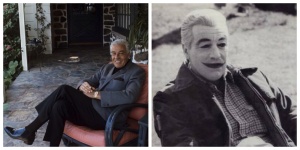
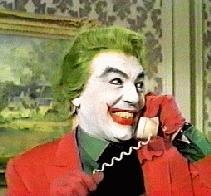
Way to go Christy. Wonderful piece on, what I think is, an under-rated actor. He could have easily been stereotyped, yet he wasn’t. Bon vivante, man-about-town, I like the background info you noted on his grandfather ( I never knew that. ) Aw geeeez…you pulled me in with your first line: “I have to admit I fell in love.” 🙂
Thank you so much for your kind comments! I had so much fun finding out more about Cesar Romero. I had to write about why I felt so compelled to write about Cesar Romero. I just have a feeling that he was proud to be related to Jose Marti, but it had to be kept quiet due to several factors, one of which might have been the 50’s political climate.
Dear Christy, as a huge longtime admirer of Cesar Romero, I too have “studied” Cesar and found out so many wonderful things about him….I love that you have shared your thoughts and created this post in dedication to him…..when I got on the net several years ago there was practically nothing about him…he had almost been forgotten…..So, besides a YT channel I have for him, I also have a Facebook group, too and I am proud to have some of Cesar’s close family as members, who have shared their memories and family photos with us from time to time…..Everyone who loves and admires Cesar, and wants to know more about him, is welcome….https://www.facebook.com/groups/17377271017/
Pingback: Hola, amigos! Day 2 of Hollywood’s Hispanic Heritage Blogathon | Movie Star Makeover
Thanks so much, Kay! I am glad you like it!
Well. What can I say? Or, let me count the ways this post reaches a very personal part of me, the Cuban me. Fraught with familial nostalgia, cultural depth, pride and a host of other things I’m unable to articulate, you’ve hit the core of this event with this wonderful post, Christy. I was originally just happy someone chose to write about Cesar Romero, but this went above and beyond. I honestly don’t know what else to say. A copy of Marti’s “Cultivo una Rosa Blanca” is near me at all times. Thank you!
Aurora
Oh, my! Reading that post you made just gave me chills, Aurora! So happy you liked it. Tickled and smiling! 🙂
I am so happy I stumbled upon this site, Christy….I have adored Cesar Romero since I was a child……I have a FB group and a YouTube channel dedicated to him…..all are welcome to join……https://www.facebook.com/groups/17377271017/
Aurora….Have you seen his 6 Cisco Kid movies?….they are my favorites….i have put them on my YouTube channel…CESAR ROMERO~THE LATIN FROM MANHATTAN….So many have commented how much they enjoy them…..http://www.youtube.com/user/anderson7293
I love it when we get the chance to see Cesar dance onscreen. Thank Heavens for those Fox musicals. His humour and humanity always shone through in comedy or drama. What a guy!
I agree, Patricia! There a so many photos of Cesar dancing in so many films, clubs, and parties, I had a difficult time choosing just a few! As for his humanity, he took good care of his family, and his appearance on What’s My Line just reaffirmed his sense of humor to me. In Donovan’s Reef, I enjoyed how much he made fun of the prima donna administrator he portrayed.
One of my favorites…..http://www.youtube.com/user/anderson7293
I enjoyed your post a lot dear Sue Sue. I was not familiar with much of the information you have included on this profile of the exuberant César Romero. From his early role in the underrated The Devil is a Woman to his Joker in the Batman series, he was always a joy to watch perform. Thanks to you I am going to make a point of checking his appearance on What’s My Line. 😉
I am so joyful that you enjoyed my post, dear Fedo. I find it difficult to fathom, though, that there is a gap in your vast areas of expertise! I have to agree with you that Cesar Romero was always a joy to watch perform. I hope you enjoy his appearance on What’s My Line because it reveals his own personal sense of security about who he was and how amiable he could be on the spur of the moment. My hope is that everyone will take a peek at your lovely essay about Dolores del Rio! 🙂
Thanks for your kindness Christy.
🙂
Pingback: Hollywood’s Hispanic Heritage Blogathon | Once upon a screen...
One of the first movies I remember seeing in a theater, other than animation, was Two on a Guillotine. My older brothers took me, scared me senseless. So Romero was a first for me too. 😉
Nice post. Thanks.
Thank you so much, voiceovermovies! Glad you like it. I had fun researching and thinking about how Cesar Romero was such a pleasure to watch on television and in film. 🙂
He made every movie better by his performance, didn’t he? One of the great actors. I really enjoyed this tribute.
Thank you so much, silverscreenings! 🙂
I too remember handsome Romero from The Little Princess, my favorite Shirley Temple movie. I wanted someone to save me from who knows what? Romero had a tiny role in my favorite movie ever, The Good Fairy. It’s a very tiny role but I recommend it. He played a lothario.
Thank you bunnybuntales! I’ve never seen the film you mention, but I will put it on my to-do list. 🙂
Wonderful, emotive post. I must admit I was guilty of judging this book by his cover, but you’ve certainly convinced me otherwise. I really must watch some more of his films. On a costume note, that red coat with the gold embroidery is wonderful, clearly worth the (not inconsiderable) price tag!
Thank you, girlsdofilm! I am so happy I surprised you. During the auction, I was keeping my eye on that coat, and I was pleased that it sold for more than the reserve price. There were several bidders. 🙂
I did not know a lot about Cesar Romero before reading your piece. I love how you did a different take on exploring him as a Hispanic in Hollywood by connecting him to his family’s culture through the words of his grandfather, whose words speak so strongly to you and now to us.
Thank you so much, Beth, for your kind comments. I enjoyed preparing and researching this article because discovering something different, something fresh and new, is exciting to me as a classic film fan, and as a writer.
I got to know Cesar as the Joker, and liked your post abou him very much. I could never imagined that he was related to Martí! And, well, he was not stereotyped: from Latin to Arabian to Italian… to a villain in Gotham City! This is a lot of acting range!
Don’t forget to read my contribution to the blogathon! 🙂
Kisses!
http://www.criticaretro.blogspot.com.br/2014/10/alegria-e-sensualidade-douglas.html
I did! I enjoyed it very much! ( In Spanish and English!) 🙂